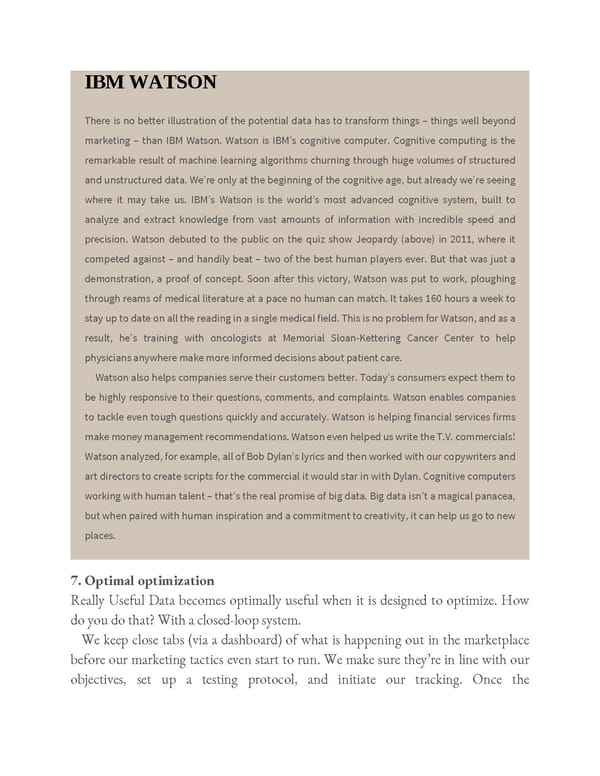IBM WATSON There is no better illustration of the potential data has to transform things – things well beyond marketing – than IBM Watson. Watson is IBM’s cognitive computer. Cognitive computing is the remarkable result of machine learning algorithms churning through huge volumes of structured and unstructured data. We’re only at the beginning of the cognitive age, but already we’re seeing where it may take us. IBM’s Watson is the world’s most advanced cognitive system, built to analyze and extract knowledge from vast amounts of information with incredible speed and precision. Watson debuted to the public on the quiz show Jeopardy (above) in 2011, where it competed against – and handily beat – two of the best human players ever. But that was just a demonstration, a proof of concept. Soon after this victory, Watson was put to work, ploughing through reams of medical literature at a pace no human can match. It takes 160 hours a week to stay up to date on all the reading in a single medical field. This is no problem for Watson, and as a result, he’s training with oncologists at Memorial Sloan-Kettering Cancer Center to help physicians anywhere make more informed decisions about patient care. Watson also helps companies serve their customers better. Today’s consumers expect them to be highly responsive to their questions, comments, and complaints. Watson enables companies to tackle even tough questions quickly and accurately. Watson is helping financial services firms make money management recommendations. Watson even helped us write the T.V. commercials! Watson analyzed, for example, all of Bob Dylan’s lyrics and then worked with our copywriters and art directors to create scripts for the commercial it would star in with Dylan. Cognitive computers working with human talent – that’s the real promise of big data. Big data isn’t a magical panacea, but when paired with human inspiration and a commitment to creativity, it can help us go to new places. 7. Optimal optimization Really Useful Data becomes optimally useful when it is designed to optimize. How do you do that? With a closed-loop system. We keep close tabs (via a dashboard) of what is happening out in the marketplace before our marketing tactics even start to run. We make sure they’re in line with our objectives, set up a testing protocol, and initiate our tracking. Once the
 Ogilvy on Advertising in the Digital Age Page 229 Page 231
Ogilvy on Advertising in the Digital Age Page 229 Page 231